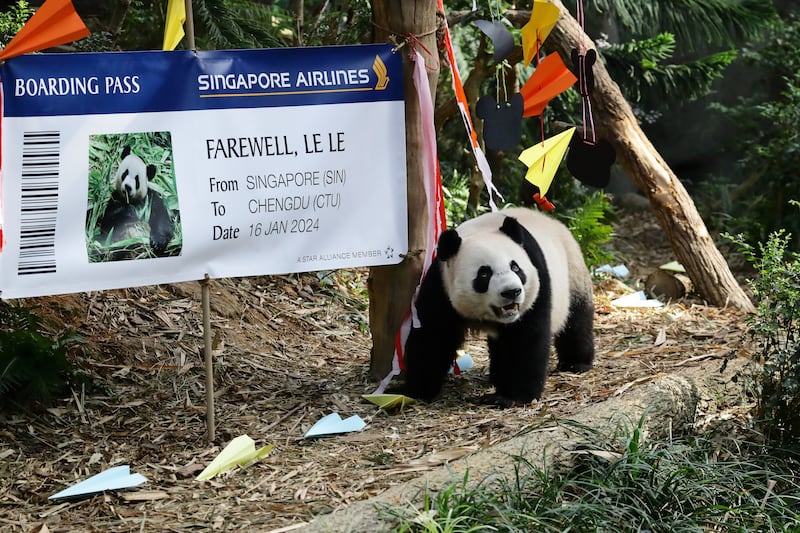Chongqing, a city in central China with a population of 32 million and a municipal area the size of Austria, this week welcomed four new residents. Giant pandas Qing Hua, Qing Lu, Qiao Yue and Ai Lian will not appear in public until they have settled into their new surroundings at Chongqing Locajoy Theme Park.
But they already have a big online following and Chinese media reports describe each of the four female pandas as showing a distinct charm of her own. This is especially true of Qing Hua and Qing Lu, who have become known as the Hualushui (eau de toilette) Sisters.
Qing Hua has a passion for sports and climbing while her younger sister, Qing Lu, radiates “intelligence and grace in her movements and eating habits”. Ai Lian is tall and slender with an aloof demeanour and Qiao Yue’s personality is “a blend of clinginess, well-mannered timidity, and heightened alertness, epitomising the essence of a gentle little girl”.
As Chongqing looks forward to viewing its new local celebrities, zoos around the world have been saying farewell to their pandas as they return home to China. Last year 17 pandas came back from the United States, Japan, France, Germany, the Netherlands and Britain, among other countries.
READ MORE
Adelaide Zoo may have to part with its two pandas this year despite a thaw in relations between Australia and China since Anthony Albanese became prime minister. The number of pandas returning to China has caused some to ask if the days of Beijing’s panda diplomacy are numbered.
The origins of panda diplomacy go back to the seventh century when the Tang Dynasty Empress Wu Zetian gave a giant panda to the Japanese emperor as a “national gift”. In 1957, Beijing sent Ping Ping to Moscow where the panda became the zoo’s most popular animal and became known as Pingka.

The following year, when Chicago Zoo tried to buy a panda from Beijing Zoo, the Chinese authorities approved the sale but the US state department refused to issue an import licence. It said that “all goods, including animals, exported from Communist China” were forbidden, prompting the People’s Daily to publish a response under the headline “Giant Pandas Frighten Paper Tigers”.
After Richard Nixon’s wife, Pat, admired a panda on a cigarette box during their visit to China in 1972, Zhou Enlai arranged for two pandas to be presented to the US as a gift. Japan restored diplomatic relations with Beijing the same year and it too received a pair of giant pandas.
[ Giant panda celebrations a reminder of better times in US-China relationsOpens in new window ]

Over the following decade, France, Germany, Britain, Spain and Mexico received pandas but the policy changed in 1982 so that pandas were no longer given as gifts. Instead they were loaned to zoos around the world on short-term leases, sometimes becoming touring animals as they moved from one zoo to another.
The policy changed again in the 1990s so that pandas were sent to zoos overseas only as part of a programme of scientific research co-operation. Leases are typically for 10 years at a cost of about US$1 million per year for each panda.
Crucially, China retains ownership of any cubs born to the pandas on loan overseas and zoos must agree to send the cubs to China when they reach the age of four. This means they are in China when they are ready to start breeding at around the age of six.
Female pandas ovulate just once a year so they have an annual window of 24-48 hours to conceive. Pandas are solitary creatures and zookeepers have tried everything to help them to get into the mood, with an expert in Germany suggesting in 2017 that panda porn was the answer.

China’s breeding programme, including its work with international partners, has been a remarkable success, bringing pandas back from the edge of extinction so that they are now classified as a vulnerable rather than an endangered species. A network of dozens of panda reserves in southwest China is restoring the connectivity of their natural habitat and safeguarding it through logging bans and other measures.
Although more pandas are living in the wild in China, international research and breeding programmes continue, as does panda diplomacy. Washington Zoo sent its three pandas back to China last year but when Xi Jinping was in San Francisco in December he suggested that more may be on the way, this time to California.
“Pandas have long been envoys of friendship between the Chinese and American peoples,” he said.
“We are ready to continue our co-operation with the United States on panda conservation and do our best to meet the wishes of the Californians so as to deepen the friendly ties between our two peoples.”
















